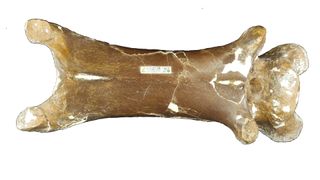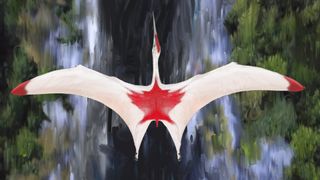Meet 'Cold Dragon of the North Winds,' the Giant Pterosaur That Once Soared Across Canadian Skies
Oh, Canada! A newfound pterosaur species is the country's first giant flying reptile.

Millions of years ago, a flying reptile as big as an airplane took flight in what is now Canada.
Now, this enormous species of giant pterosaur — part of a group known as azhdarchids — finally has a name: Cryodrakon boreas, drawing from the ancient Greek words that translate to "cold dragon of the north winds."
Fossils of Cryodrakon boreas were found decades ago, and were thought to belong to another North American azhdarchid: Quetzalcoatlus, one of the biggest flying animals of all time. But the discovery of additional fossils in recent years told scientists that the fossils represented a newfound species, and the first new species of giant pterosaur found in Canada.
Based on the size of one enormous neck bone thought to belong to an adult animal, the newly described pterosaur likely had a wingspan extending about 33 feet (10 meters) from tip to tip, making it comparable in size to its monstrous azhdarchid cousin Quetzalcoatlus, researchers reported in a new study.
Related: Photos of Pterosaurs: Flight in the Age of Dinosaurs
All of the Cryodrakon fossils came from Dinosaur Provincial Park in Alberta, and date to approximately 77 million to 74 million years ago during the Cretaceous period (145.5 million to 65.5 million years ago), according to the study.
Azhdarchids lived on all continents except Antarctica and Australia, and are known for having supersize heads, long necks, long legs and large feet, said lead study author David Hone, a senior lecturer and director of the biology program at Queen Mary University in London. But despite this group's massive size, very few fossils of the flying giants remain, Hone told Live Science in an email.
Sign up for the Live Science daily newsletter now
Get the world’s most fascinating discoveries delivered straight to your inbox.

Fossils are typically preserved when animal remains are buried in layers of sediment and locked away from bacteria that break down organic matter. Many of the best-preserved remains from millions of years ago belonged to animals that lived near seas or rivers, and pterosaurs at this time (including Cryodrakon) mostly lived inland, Hone explained.
"And their bones are insanely thin, so they are very rare," he added. "We're lucky we have as much good material as we do."
What might C. boreas have looked like in life? Paleoartist David Maas illustrated the pterosaur with a distinctive pattern of red and white that will likely be immediately recognizable to any Canadian. Viewed from above with its wings at full spread, the markings across Cryodrakon's back and wingtips strongly resemble the Canadian flag, down to the iconic maple leaf in the center.

This was a "fun" artistic choice, as there's no fossilized evidence of the animal's colors or patterns, Hone told Live Science in the email. Nevertheless, "it's actually a plausible colour scheme," he added.
"It's nothing ridiculous or impossible based on what we know about the colours of large living birds," Hone said.
The findings were published online Sept. 9 in the Journal of Vertebrate Paleontology.
- Photos: Ancient Pterosaur Eggs & Fossils Uncovered in China
- In Images: A Butterfly-Headed Winged Reptile
- In Photos: Bizarre 'Bat Dinosaur' Discovered in China
Originally published on Live Science.

Mindy Weisberger is an editor at Scholastic and a former Live Science channel editor and senior writer. She has reported on general science, covering climate change, paleontology, biology, and space. Mindy studied film at Columbia University; prior to Live Science she produced, wrote and directed media for the American Museum of Natural History in New York City. Her videos about dinosaurs, astrophysics, biodiversity and evolution appear in museums and science centers worldwide, earning awards such as the CINE Golden Eagle and the Communicator Award of Excellence. Her writing has also appeared in Scientific American, The Washington Post and How It Works Magazine.
Most Popular

